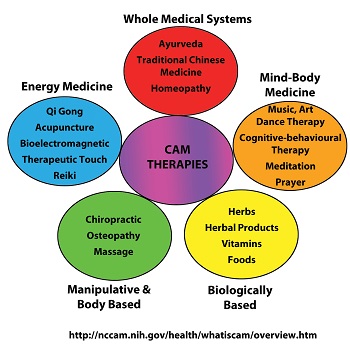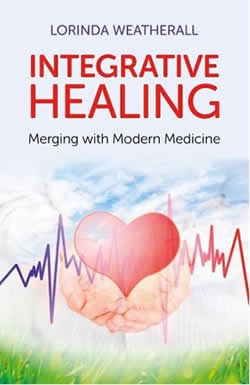Positive Health Online
Your Country

Integrative Healing - Practical Guide to Professionalism
by Lorinda Weatherall(more info)
listed in integrated medicine, originally published in issue 214 - May 2014
In an effort to establish some common ground this are the working definitions for the term: Alternative, Complementary and Integrative. Please understand that these are broad generalizations.
Alternative is defined: noun - any of a range of medical therapies that are not regarded as orthodox by the medical profession, such as herbalism, homeopathy, and acupuncture, naturopathy, and crystal healing. (old term);
Complementary: noun - any of a range of medical therapies that fall beyond the scope of conventional medicine but may be used alongside it in the treatment of disease and ill health. Examples include acupuncture and osteopathy. (current term);
Integrative - adjective - serving or intending to unify separate things: Medicine combining allopathic and complementary therapies: a database for the integrative physician. (evolving term).

The older term Alternative Medicine seems to apply to hippies, tree huggers, granola eaters, those who wear socks with Birkenstocks kind of people. You know the weird ones. These kinds of folks have a tendency disregard and use these other forms of healthcare instead of allopathic medicine.
The current term of Complementary is applying to folks who use both types of healthcare. These folks may not disclose to their current Allopathic healthcare provider that they are seeking treatment from a Chiropractor, Naturopath, Traditional Chinese Medicine (TCM) practitioner, Massage Therapist or Energy Therapist for fear of ridicule or being terminated as a patient. This type of patient / client may go to the Allopathic provider to get diagnostic tests or referrals to a specialist, then take a copy of this data to their Complementary Practitioner to get a second opinion and/or work out a treatment plan.
Now comes the exciting part, the evolving term of Integrative Medicine is where the Allopathic medicine provider is trained in some of the Complementary Modalities such as Acupuncture and TCM - University of California, San Francisco.
www.osher.ucsf.edu/patient-care/treatments-services/acupuncture-and-traditional-chinese-medicine Accessed February 2014.
Some of the more traditional medical schools like Harvard and John Hopkins are offering programs in Integrative Medicine.
www.medcatalog.harvard.edu/coursedetails.aspx?cl=elective&id=18242 Accessed February 2014.
http://brighamandwomens.org/Departments_and_Services/medicine/services/oshercenter/Education-Initiatives.aspx Accessed February 2014.
www.hopkinsmedicine.org/cam/index.html Accessed February 2014.
It has been my experience that clients seek out complementary practitioners because they do not feel valued, or listened to by their current healthcare provider. An individual may seek out a CAM practitioner after a loved one dies, based upon the type of care the deceased had received.
Now that we have a common frame of reference, let’s get to the meat and potatoes of this article - CAM practitioners being professional. This topic is huge and can cover a lot of territory from the simple such as business cards all the way to Therapeutic Boundaries and Ethics. So let’s begin.
Our career choices have exploded over the years; no longer are we bound to carry out the tasks our parents did like baker, tailor, soldier or sailor. Sure, there are still the common ones of doctor, lawyer, teacher, fireman and farmer. In the Complementary Therapies we have Homeopaths, Naturopaths, Traditional Chinese Medicine (TCM), Ayurveda, Herbalist, Registered Massage, Bowen Technique, Cranial-sacral, Shiatsu, Reflexology, Yoga, Tai Chi , Qi Gong, Mindfulness Meditation, Art therapy, Music therapy, Emotional Freedom Techniques (EFT), Body Talk, the Bars, a multitude of Reiki forms and the list goes on. So which one is best for you?
Regardless of which therapy/modality you practise, each and every one of us who wishes to be classified as a professional needs to take their game up a notch.
Let’s start at the beginning.
- Where would you go to be trained?
- How long do you study for?
- Is the school/college/institution recognized for producing quality students?
- Do they have a professional association you can join or can the teaching facility recommend one?
- Do they offer continuing education courses or do they have a list of appropriate continuing education credits (CEU) through their academic partners?
- Is this school/college/institution keeping their members informed of changing government regulations? Will they advocate on your modality’s behalf?
When shopping around for a place of higher learning, it is no different than trying to find a great mechanic, hairdresser, dentist or building contractor. Get referrals, ask questions, talk to friends and graduates of that facility. Don’t be misled by all the ‘positive only’ testimonials on someone’s website.
Congratulations! After all your hard work - you’ve passed and graduated - now what?
This is an overly simplified example. In some modalities like the Manipulative and Body Based and Whole Medical Systems, there is usually an apprenticeship or clinical aspect to what the students learns. After attaining the required number of clinical hours and the required theory elements, the student is permitted to apply to write a professional board exam.
These newly graduated professionals should be familiar with the existing governmental legislation, scope of practice, ethics, therapeutic boundaries and professionalism. It would be relatively easy for these professionals to set up or join an existing holistic practice.
Let’s turn our attention to the less structured or softer ‘folk’ arts. When I learned Ear Candling almost 20 years ago, the course was six or eight hours. The instructor was not required to teach us the anatomy of the ear as they were not a medical professional. However, we learned the components that made up the external part of the ear: the Pinna (outer ear) the External auditory canal and the Tympanic membrane (ear drum). We were told the history of ear candling and what it was used for. The instructor demonstrated on a volunteer - then the class was asked to do the same. Tools required: an aluminium pie plate with a hole slightly off centre to catch any ash falling from the lit fabric and wax candle, towel for head covering, a pair of scissors, lighter and a bowl of water.
Back in the 1990s, times were different; these folk arts were considered harmless and safe. The instructor never mentioned that our clients needed to sign consent and release form, nor did we discuss informed consent. Knowing what I know now - the client should have been made aware that Ear Candling does come with risks. For instance, hot wax can drip down the inside of the fabric/wax tube and pass through the opening of the tube and land on the client’s ear drum. When stated in this manner, I wonder how many of us would have continued with the course. It is possible to offer our clients a positive therapeutic Ear Candling experience; we just need to plan ahead. Some countries have banned this activity saying it is invasive and therefore a medical procedure.
This example stimulated a whole bunch of related thoughts. Most people who practise these ‘folk’ arts use them to benefit friends, family and themselves. On occasion, the practitioner decides to broaden their horizons and turn it into a little business, as family members have referred you to their friends and so on.
Normally, this involves getting business cards, brochures, joining various networking groups and maybe taking a course or two. As the practitioner gets busier their practice moves from the home office to a professional space. My personal business was registered in 1998 and a lot of changes have happened since then. In order to gain some kind of credibility as a Reiki practitioner I joined the Canadian Reiki Association. I understand this is run by a group of volunteers as are most CAM organizations, but they haven’t kept up with changing legislation either. In 2004 the Canadian government implemented the Privacy Act and while most readers will be familiar with Doctors and Lawyers being bound by this - Complementary Health Practitioners are bound by it too. Check with your National Government to see what kind of legislation you should be following regarding the privacy documents your client’s sign. If you are in contravention of this legislation the practitioner can be fined a hefty sum. I was unaware of all this until 2007, did you know?
So what kind of documents are we talking about here?
When a client not patient comes to see you for a consultation do you have them fill in the Informed Consent and Release form?
- This form contains sensitive personal information of your client: Name, Address, Phone number, Email;
Does it include a health history including medication? - All this needs to be protected, in a lockable filing cabinet.
If you store your records - paper copies or computer files - off site, are they secure until you get home? This includes any personal notes you may have made regarding your client’s condition; - Have you joined a professional association that supports the Therapy you practise?
- Has the association requested you sign a Code of Ethics, do you follow a Code of Conduct, is there a disciplinary process established should a client wish to complain about a practitioner‘s misconduct?
- Do they offer or can they refer you to an Insurance company for liability insurance?
- Are you familiar with the term Scope of Practice and do you adhere to it? Or do you have the view that more tools in your healing tool box is to the client’s benefit?
What does it mean to be a Professional - its’ more than a website, phone number and business card. For those of us in the CAM field we are also accountable for our advertising claims. Unless you have the scientific research to back it up - saying that Therapy XZY will cure XYZ ailment is misleading; now you are promoting yourself as a Medical Professional without a licence. CAM practitioners are also bound by client-therapist confidentiality. Anything discussed in session stays in confidence. Don’t go home and share it with your significant other, or talk about it to a friend in the grocery store.
While we are on the topic of conversation how do you talk to your client?
- Is it active listening or condescending? Sort of like the ‘professional’ knows best kind of mentality. There is a term for this: it’s called therapeutic privilege or medical paternalism, and it’s wrong. The client is entitled to their own thoughts and opinions even if you feel otherwise. These are changing and exciting times for CAM practitioners; we need to unite as a group to form common alliances as we move forward to build that bridge with the Allopathic/Biomedical model.
If CAM professionals want to be included as part of the healthcare team, then we have a lot of homework to do. We need to sit down and take a really hard look at ourselves and our practice to see if we measure up to what the consumer and Allopathic/Biomedicine expects of us. We need to be clear in our message of what our CAM Therapy can do and be honest in saying what it can’t.

This is just a snippet of some of the items discussed in Integrative Healing Merging with Modern Medicine. Walk with me on this journey. Feel free to contact me regarding any questions or concerns or if you have any insights I might have missed.
Further Information
Available from Amazon:
www.amazon.co.uk/Integrative-Healing-Merging-Modern-Medicine/dp/1846949637
www.amazon.com/Integrative-Healing-Merging-Modern-Medicine/dp/1846949637
Comments:
-
No Article Comments available